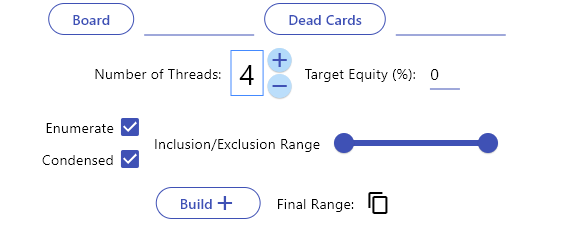Range Builder
The range builder builds a range by reducing your initial range. This can be achieved by getting rid of your best and worst cards (condensed range) or by getting rid of middling cards (polarized range).
At the top you have the following:
- Starting Range: this is your initial range that you want to modify with the constraints selected.
- Number of opponents: between 1 and the maximum allowed (6 at the moment).
- Opponents Ranges: The static opponent ranges that you are facing.

You also have the following settings:

- Board: public cards dealt by the dealer.
- Dead Cards: cards that nobody still in the game can have and that won't be dealt to the board (an example would be cards of a player that has folded and showed his holding)
- Number of threads: CPU threads to carry on the calculation.
- Target equity: this is the equity you want your final range to have. If the initial equity is 30% and the target equity is 20%, it will get rid of cards with an equity above 20%. The inverse will happen if the initial equity is below 20%, it will take out cards with lower equity.
- Enumerate: whether to calculate the starting equity using enumeration or monte carlo simulation (exact vs approximate). For 2 players it's recommended to use enumeration as the result is exact and it doesn't usually take long. For more players it depends on what street you are and how big are the ranges. After all, this is a personal choice.
- Condensed: condensed means you want a condensed range, as opposed to polarized. With a condensed range you will be eliminating cards from the top and the bottom of your starting range. With a polarized range it will be cards with an equity right above or below of your target equity.
- Inclusion/Exclusion Range: when targeting a condensed range, all cards must have an equity within the slider limits. If a polarized range is selected, then all cards have to be outside of the slider limits.
Once you run the range builder, you can copy the final range using the button and paste it wherever you want.